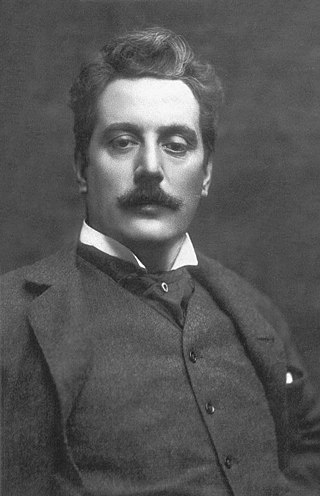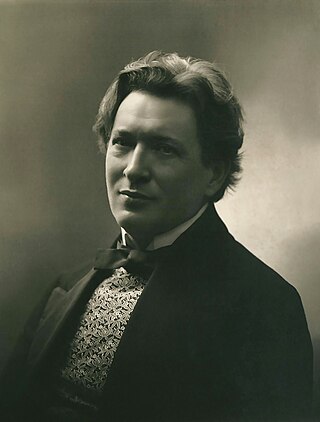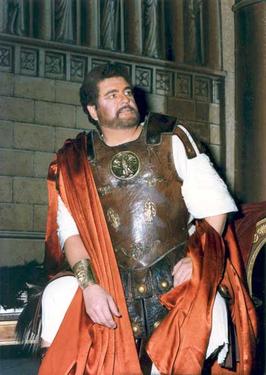
Giacomo Antonio Domenico Michele Secondo Maria Puccini was an Italian composer known primarily for his operas. Regarded as the greatest and most successful proponent of Italian opera after Verdi, he was descended from a long line of composers, stemming from the late-Baroque era. Though his early work was firmly rooted in traditional late-19th-century Romantic Italian opera, he later developed his work in the realistic verismo style, of which he became one of the leading exponents.

Turandot is an opera in three acts by Giacomo Puccini to a libretto in Italian by Giuseppe Adami and Renato Simoni. Puccini left the opera unfinished at the time of his death in 1924; it premiered in 1926 after the music was posthumously completed by Franco Alfano.

Ferruccio Busoni was an Italian composer, pianist, conductor, editor, writer, and teacher. His international career and reputation led him to work closely with many of the leading musicians, artists and literary figures of his time, and he was a sought-after keyboard instructor and a teacher of composition.

Carlo, Count Gozzi was an Italian (Venetian) playwright and champion of Commedia dell'arte.

Franco Alfano was an Italian composer and pianist, best known today for his operas Cyrano de Bergerac (1936), Risurrezione (1904) and for having completed Puccini's opera Turandot in 1926. He had considerable success with several of his own works during his lifetime.
"In questa reggia" is an aria from Giacomo Puccini's opera Turandot set to a libretto in Italian by Giuseppe Adami and Renato Simoni. The text is based on Friedrich Schiller's adaptation of the play Turandot by Carlo Gozzi. The aria takes place in scene two of the second act, and is sung mostly by the Princess Turandot (soprano), but with a reply from Calaf (tenor), which is a key point of the opera.

Jean-Pierre Ponnelle was a French opera director, set and costume designer.

Turandot (1762) is a commedia dell'arte play by Count Carlo Gozzi after a supposedly Persian story from the collection Les Mille et un jours (1710–1712) by François Pétis de la Croix. Gozzi's Turandot was first performed at the Teatro San Samuele, Venice, on 22 January 1762.

Arlecchino, oder Die Fenster is a one-act opera with spoken dialog by Ferruccio Busoni, with a libretto in German, composed in 1913. He completed the music for the opera while living in Zurich in 1916. It is a number opera written in neo-classical style and includes ironic allusions to operatic conventions and situations typical of the late 18th and early 19th centuries. It even includes a parody of a duel.

Carlo Cossutta was a prominent Italian dramatic tenor of Slovene descent who had a major international opera career that spanned from the mid-1950s through the late 1990s. He began and ended his career at the Teatro Colón in Buenos Aires where he sang regularly from 1958 through 1998. He first drew international attention in 1964 when he sang the title role in the world premiere of Alberto Ginastera's Don Rodrigo, which led to a series of appearances at the Royal Opera, London during the 1960s. In the 1970s his international career skyrocketed with appearances at most of the major opera houses in Europe and the United States. He remained active on the international stage during the 1980s but his career slowed down significantly in the 1990s after he contracted liver cancer.

Doktor Faust is an opera by Ferruccio Busoni with a German libretto by the composer, based on the myth of Faust. Busoni worked on the opera, which he intended as his masterpiece, between 1916 and 1924, but it was still incomplete at the time of his death. His pupil Philipp Jarnach finished it. More recently, in 1982, Antony Beaumont completed the opera using sketches by Busoni that were previously thought to have been lost. Nancy Chamness published an analysis of the libretto to Doktor Faust and a comparison with Goethe's version.

Ferruccio Busoni discography is a list of recordings of music composed or adapted by Ferruccio Busoni. For recordings of music with Busoni as pianist, see Ferruccio Busoni discography.

The Turandot Suite, Op. 41 is an orchestral work by Ferruccio Busoni written in 1904–5, based on Count Carlo Gozzi's play Turandot. The music – in one form or another – occupied Busoni at various times between the years 1904–17. Busoni arranged the suite from incidental music which he was composing to accompany a production of Gozzi's play. The suite was first performed on 21 October 1905, while the play with his incidental music was not produced until 1911. In August 1916 Busoni had finished composing the one-act opera Arlecchino, but it needed a companion work to provide a full evening's entertainment. He suddenly decided to transform the Turandot music into a two-act opera with spoken dialog. The two works were premiered together as a double-bill in May 1917.
Lucilla Udovich was an American soprano of Croatian ancestry.
William Brown was an American operatic tenor, a founding member of the Center for Black Music Repertory Ensemble and a Distinguished Professor of Voice at the University of North Florida.

Princess Turandot is a 1934 German comedy film directed by Gerhard Lamprecht and starring Käthe von Nagy and Willy Fritsch. A separate French-language version, Turandot, Princess of China, was also released.

Jürgen Maehder is a German musicologist and opera director. He discovered Franco Alfano's original version of the finale for the third act of Puccini's Turandot. He has lectured and staged opera internationally.

Kii-Ming Lo, born November 4, 1954, in Keelung, is a Taiwanese musicologist.
Les Mille et un jours, contes persans is a short story collection with Middle Eastern settings published between the years 1710 and 1712 by the French orientalist François Pétis de la Croix, probably with unacknowledged help from Alain-René Lesage. Though the stories were for the most part adapted very freely from a 15th-century Turkish collection called Ferec baʿde şidde, in its structure it is modelled on Antoine Galland's Les Mille et une nuits, whose immense success it was intended to share. It has had a wide influence on European culture, not least through its retelling of the story of Turandot, which indirectly inspired Puccini's opera and many other works.
















